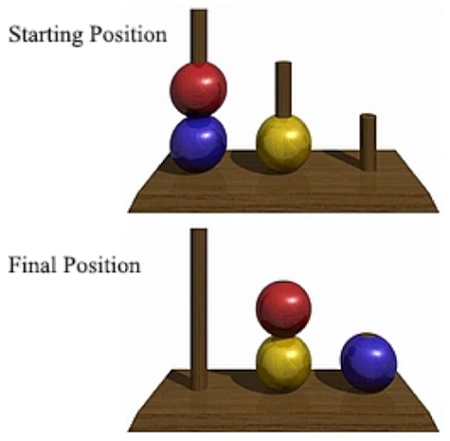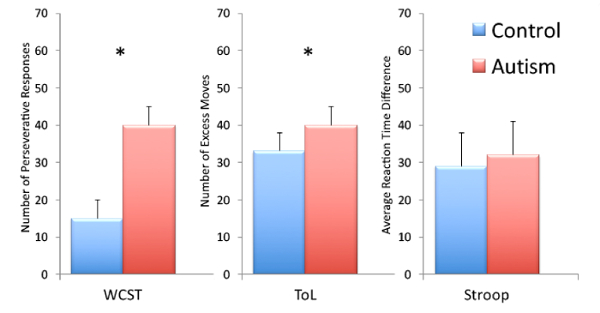Executive Function in Autism Spectrum Disorder
Overview
Source: Laboratories of Jonas T. Kaplan and Sarah I. Gimbel—University of Southern California
Attention, working-memory, planning, impulse control, inhibition, and mental flexibility are important components of human cognition that are often referred to as executive functions. Autism spectrum disorder is a developmental disorder that is characterized by impairments in social interaction, communication, and repetitive behaviors. It is a disorder that lasts a lifetime, and is thought to affect 0.6% of the population. The symptoms of autism suggest a deficit in executive function, which may be assessed by specialized neuropsychological tests. By employing several tests that each emphasize different aspects of executive function, we can gain a more complete picture of the cognitive profile of the disorder.
One such task, known as the Wisconsin Card Sorting Test (WCST), is a cognitively complex task used widely in research and clinical studies as a highly sensitive measure of deficits in executive function. It tests a person's ability to shift attention and tests their flexibility with changing rules and reinforcement.1 In the WCST, a participant is presented with four stimulus cards, incorporating three stimulus parameters: color, shape, and number. The participant is asked to sort response cards according to different principles, changing their sorting criteria based on feedback from the experimenter. Participants try out different rules until they find the correct method for sorting the cards. Patients with executive dysfunction tend to get stuck in the card sorting task, unable to change their sorting strategy. This persistence with an incorrect strategy is called perseveration.
A second task, The Tower of London (ToL) is a test dependent on complex planning, re-evaluation, and updating of planned moves. Individuals with autism have been reported to be impaired on tasks involving planning.2 In the ToL task, individuals must move disks from a prearranged sequence on three pegs to match a goal state in as few moves as possible, following specific rules.
A third task, known as the Stroop test, targets cognitive inhibition. In this task participants are shown a name of a color, written in a different color, and are asked to identify the color the word is written in. For example, in an incongruent condition, the word blue would be written in green. Individuals with inhibition difficulty should not perform as well as typically developing individuals on this task involving inhibition of the written word.
In this video, we show how to administer the WCST, ToL, and Stroop task to compare flexibility, planning, and inhibition in children with autism spectrum disorder and typically developing counterparts, and explore how each of these groups performs on these different aspects of executive function.
Procedure
1. Participant recruitment
- Autistic population recruitment
- Recruit 40 participants, aged 6-18 years, with autism spectrum disorder. Diagnosis of autism can be verified using the Autism Diagnostic Interview-Revised3 and the Autism Diagnostic Observation Schedule.4
- Control population recruitment
- Recruit 40 participants aged 6-18 years, who are matched in age and intellect with the autistic participant population.
- Make sure that the participants have been fully informed of the research procedures and have signed all the appropriate consent forms.
2. Data collection

Figure 1. Four stimulus cards presented on the computer screen. These cards are used as the categories to match each of the 64 cards from the deck. Cards can match based on three rules: number, color, and/or shape.
- Wisconsin Card Sorting Test (WCST)
- Have the participant sit at a table in front of a computer.
- Tell the participant that the game requires the matching of a single card to one of four cards displayed at the top of the screen (Figure 1).
- After matching each card, the participant is informed if the correct or incorrect decision was made, based on if they guessed the rule correctly or not (the rules are predetermined for each card match).
- The rule is applied for a run of trials (10 correct card placements) and then changed without warning.
- Tell the participant:
- You have four cards placed face up and a pack of 64 cards to match to them.
- There is a rule for matching the cards and you will need to guess what it is.
- Your task is to choose which card matches your card, based on the rule in place.
- You will be told "correct" or "incorrect."
- You can take as long as you like for each decision, but may not change your mind.
- You should attempt to get as many right as possible.
- From time to time, the rule will change without you being told. You will then need to discover the new rule.
- End the task when rules have been followed for 10-card turns six times, or when all 64 cards have been placed.
- Tower of London (ToL)
- The participant sits at a table in front of a computer.
- The computer screen shows a starting configuration of three colored balls that are arranged in a pattern on three different pegs. The screen also shows a goal configuration in which the balls have been re-arranged into a new configuration on the pegs.
- Tell the participant:
- Preplan a series of moves to reconfigure the start set of balls to the goal set (Figure 2).
- Execute the moves one by one, using the computer mouse, using as few moves as possible.
- There is no time limit, but once a ball is moved, the move cannot be undone.
- End the task when the participant has completed 20 trials.

Figure 2. Tower of London: Starting and final position of the colored balls on the three pegs. Participants are instructed to move balls from a prearranged sequence on three different pegs to match a goal state in as few moves as possible.
- Stroop task
- The participant sits at a table in front of a computer.
- Tell the participant:
- A word will appear on the screen. Please say the color that the word is written in (Figure 3).
- Present 120 trials, consisting of equal numbers of congruent and incongruent trials.
- On each trial, present one of four color words (red, blue, green, or yellow) on the screen for 4.0 s or until a response is made. On half of the trials the ink color matches the word (congruent trials), while on the other half of the trials the ink color does not match the word (incongruent trials).
- Wait 1.5 s between each stimulus, and do not repeat the color name or presentation color from one trial to the next.
- The experimenter records if each response is correct or incorrect. Incorrect responses will be excluded from the reaction time analysis.

Figure 3. Stroop Test: Examples of a congruent and incongruent stimulus, with correct responses. Participants are instructed to verbally say the color of the word presented.
3. Data analysis
- The WCST is scored by the computer according to the WCST manual.5
- For this study, the primary index of executive dysfunction used is the number of perseverative responses in which the participant continued to sort based on the previously correct rule despite feedback that it was incorrect.
- The computerized version of the ToL is scored automatically based on: time spent preplanning, mean move times, number of moves made, and number of trials solved in the minimum number of moves possible.
- For this study, the primary index of executive dysfunction used is number of excess moves, which counts the number of moves made beyond the minimum required to solve the puzzle.
- The computerized version of the Stroop test is scored automatically by recording the time of onset of the spoken color name.
- The average reaction time for congruent trials is subtracted from the average reaction time for incongruent trials for each participant, excluding incorrect responses.
- A t-test can be used to test differences in these scores between autistic and control participants.
Results
Individuals with autism perform significantly worse on tests of mental flexibility and planning, but do not show a difference from typically developing individuals in tests of inhibition (Figure 4). 6 In the WCST, a test measuring mental flexibility, individuals with autism are less able to set-shift, adjusting to a new sorting rule mid-task (i.e., they make more perseverative errors). Consistent deficits have been found in the total number of categories correctly identified and the total number of errors made (Figure 4, left). The ToL test can be used to examine specific aspects of difficulty in planning. Even though the autistic group was impaired in relation to the control group (Figure 4, middle), this deficit was evident only on puzzles that required longer sequences of moves. On the classic Stroop test of inhibition, autistic participants were not impaired in comparison to typically developing participants (Figure 4, right). In summary, autistic and normally developing children show a difference in performance on tasks of planning and mental flexibility, but not on this task of inhibition.

Figure 4. Performance on the Wisconsin Card Sorting Test (WCST), Tower of London test (ToL) and Stroop task. Participants in the autism group (blue) were more impaired on the WCST and ToL tests, but there was no difference between the autism group and control group (red) in the Stroop task.
Application and Summary
This cognitive battery of tasks to examine executive function could possibly be used as a diagnostic marker for autism. While there are many disorders of executive function, it is possible that the pattern of performance on different tests examining different components of executive function may lead to a dissociation between different disorders. Executive function disorders such as autism, ADHD, Tourette's syndrome, and conduct disorder may have differing executive profiles in regard to these, and related, tasks. If a specific, yet differential, profile of executive dysfunction can be identified in these disorders, then it could be possible to use measures of executive function as a marker for the diagnosis of autism. Furthermore, understanding the specific profile of cognitive disabilities in this disorder can help develop more targeted rehabilitation and training programs.
Skip to...
Videos from this collection:

Now Playing
Executive Function in Autism Spectrum Disorder
Neuropsychology
18.0K Views

The Split Brain
Neuropsychology
68.6K Views

Motor Maps
Neuropsychology
27.7K Views

Perspectives on Neuropsychology
Neuropsychology
12.2K Views

Decision-making and the Iowa Gambling Task
Neuropsychology
33.2K Views

Anterograde Amnesia
Neuropsychology
30.6K Views

Physiological Correlates of Emotion Recognition
Neuropsychology
16.4K Views

Event-related Potentials and the Oddball Task
Neuropsychology
27.7K Views

Language: The N400 in Semantic Incongruity
Neuropsychology
19.8K Views

Learning and Memory: The Remember-Know Task
Neuropsychology
17.4K Views

Measuring Grey Matter Differences with Voxel-based Morphometry: The Musical Brain
Neuropsychology
17.5K Views

Decoding Auditory Imagery with Multivoxel Pattern Analysis
Neuropsychology
6.5K Views

Visual Attention: fMRI Investigation of Object-based Attentional Control
Neuropsychology
42.4K Views

Using Diffusion Tensor Imaging in Traumatic Brain Injury
Neuropsychology
16.9K Views

Using TMS to Measure Motor Excitability During Action Observation
Neuropsychology
10.3K Views
Copyright © 2025 MyJoVE Corporation. All rights reserved